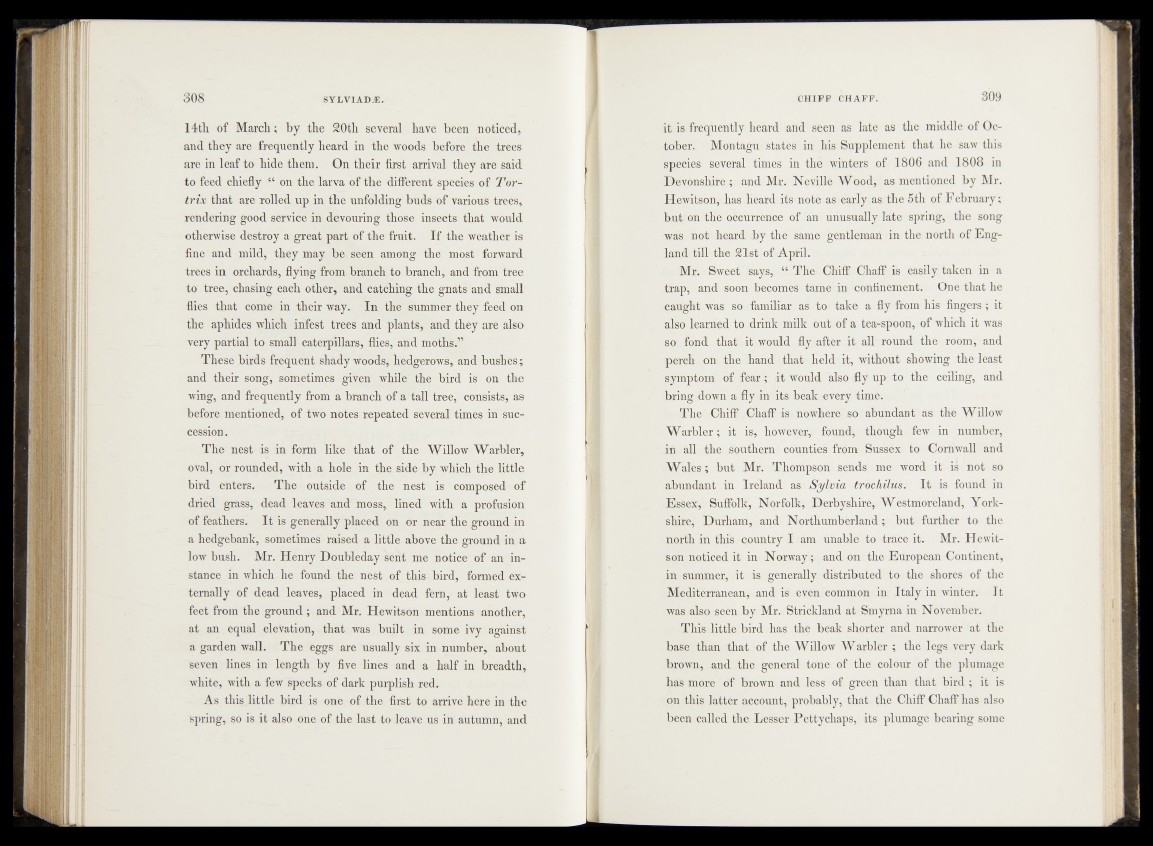
14th of March; by the 20th several have been noticed,
and they are frequently heard in the woods before the trees
are in leaf to hide them. On their first arrival they are said
to feed chiefly “ on the larva of the different species of Tor-
trix that are rolled up in the unfolding buds of various trees,
rendering good service in devouring those insects that would
otherwise destroy a great part of the fruit. If the weather is
fine and mild, they may be seen among the most forward
trees in orchards, flying from branch to branch, and from tree
to tree, chasing each other, and catching the gnats and small
flies that come in their way. In the summer they feed on
the aphides which infest trees and plants, and they are also
very partial to small caterpillars, flies, and moths.”
These birds frequent shady woods, hedgerows, and bushes;
and their song, sometimes given while the bird is on the
wing, and frequently from a branch of a tall tree, consists, as
before mentioned, of two notes repeated several times in succession.
The nest is in form like that of the Willow Warbler,
oval, or rounded, with a hole in the side by which the little
bird enters. The outside of the nest is composed of
dried grass, dead leaves and moss, lined with a profusion
of feathers. I t is generally placed on or near the ground in
a hedgebank, sometimes raised a little above the ground in a
low bush. Mr. Henry Doubleday sent me notice of an instance
in which he found the nest of this bird, formed externally
of dead leaves, placed in dead fern, at least two
feet from the ground ; and Mr. Hewitson mentions another,
at an equal elevation, that was built in some ivy against
a garden wall. The eggs are usually six in number, about
seven lines in length by five lines and a half in breadth,
white, with a few specks of dark purplish red.
As this little bird is one of the first to arrive here in the
spring, so is it also one of the last to leave us in autumn, and
it is frequently heard arid seen as late as the middle of October.
Montagu states in his Supplement that he saw this
species several times in the winters of 1806 and 1808 in
Devonshire ; and Mr. Neville Wood, as mentioned by Mr.
Hewitson, has heard its note as early as the 5th of February;
but on the occurrence of an unusually late spring, the song
was not heard by the same gentleman in the north of England
till the 21st of April.
Mr. Sweet says, “ The Chiff Chaff is easily taken in a
trap, and soon becomes tame in confinement. One that he
caught was so familiar as to take a fly from his fingers ; it
also learned to drink milk out of a tea-spoon, of which it was
so fond that it would fly after it all round the room, and
perch on the hand that held it, without showing the least
symptom of fear; it would also fly up to the ceiling, and
bring down a fly in its beak every time.
The Chiff Chaff is nowhere so abundant as the Willow
Warbler; it is, however, found, though few in number,
in all the southern counties from Sussex to Cornwall and
Wales; but Mr. Thompson sends me word it is not so
abundant in Ireland as Sylvia trochilus. I t is found in
Essex, Suffolk, Norfolk, Derbyshire, Westmoreland, Yorkshire,
Durham, and Northumberland ; but further to the
north in this country I am unable to trace it. Mr. Hewitson
noticed it in Norway; and on the European Continent,
in summer, it is generally distributed to the shores of the
Mediterranean, and is even common in Italy in winter. It
was also seen by Mr. Strickland at Smyrna in November.
This little bird has the beak shorter and narrower at the
base than that of the Willow Warbler ; the legs very dark
brown, and the general tone of the colour of the plumage
has more of brown and less of green than that bird ; it is
on this latter account, probably, that the Chiff Chaff has also
been called the Lesser Pettychaps, its plumage bearing some